西安电子科技大学:《神经网络与模糊系统 Neural Networks and Fuzzy Systems》课程PPT课件讲稿(2006)Chapter 06 Architecture and Equilibria 结构和平衡
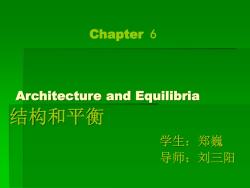
Chapter 6 Architecture and Equilibria 结构和平衡 学生:郑巍 导师:刘三阳
Architecture and Equilibria 结构和平衡 学生:郑巍 导师:刘三阳 Chapter 6
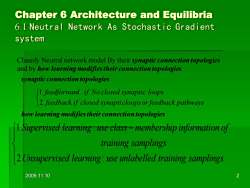
Chapter 6 Architecture and Equilibria 6.1 Neutral Network As Stochastic Gradient system Classify Neutral network model By their synaptic connection topologies and by how learning modifies their connection topologies synaptic connection topologies (1.feedforward.if No closed synaptic loops 2.feedback if closed synapticloops orfeedback pathways how learning modifies their connection topologies 1.Supervised learning:use class-membership information of training samplings 2.Unsupervised learning:use unlabelled training samplings 2006.11.10 2
2006.11.10 2 Chapter 6 Architecture and Equilibria 6.1 Neutral Network As Stochastic Gradient system Classify Neutral network model By their synaptic connection topologies and by how learning modifies their connection topologies feedback i f closed synapticloops orfeedback pathways feedforward i f No closed synaptic loops 2. . 1. . 1. : 2. : Supervised learning use class membership information of training samplings Unsupervised learning use unlabelled training samplings − synaptic connection topologies how learning modifies their connection topologies
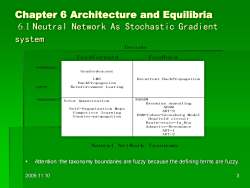
Chapter 6 Architecture and Equilibria 6.1 Neutral Network As Stochastic Gradient system Decode Feedforward Feedback s口二 Gradiedescent LMS Recurrent BackPropagation BackPropagation 1 Reinforcement Learing Vetor Quantization RABAM Broenian annealing Self-Organization Maps ABAM Competitve learning ART-2 Counter-propagation BAM-Cohen-Grossberg Model Hopfield circuit Brain-state-In_Box Adaptive-Resonance ART-1 ART-2 Neural NetWork Taxonomy Attention the taxonomy boundaries are fuzzy because the defining terms are fuzzy. 2006.11.10 3
2006.11.10 3 Chapter 6 Architecture and Equilibria 6.1 Neutral Network As Stochastic Gradient system ▪ Attention :the taxonomy boundaries are fuzzy because the defining terms are fuzzy. Gradiedescent LMS BackPropagation Reinforcement Learing Recurrent BackPropagation Vetor Quantization Self-Organization Maps Competitve learning Counter-propagation RABAM Broenian annealing ABAM ART-2 BAM-Cohen-Grossberg Model Hopfield circuit Brain-state-In_Box Adaptive-Resonance ART-1 ART-2 Feedforward Feedback Decode d e s i v r e p u S d e s i v r e p u s n U e d o c n E Neural NetWork Taxonomy
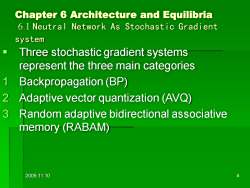
Chapter 6 Architecture and Equilibria 6.1 Neutral Network As Stochastic Gradient system Three stochastic gradient systems represent the three main categories 1 Backpropagation (BP) 2 Adaptive vector quantization (AVQ) 3 Random adaptive bidirectional associative memory (RABAM) 2006.11.10 4
2006.11.10 4 Chapter 6 Architecture and Equilibria 6.1 Neutral Network As Stochastic Gradient system ▪ Three stochastic gradient systems represent the three main categories 1 Backpropagation (BP) 2 Adaptive vector quantization (AVQ) 3 Random adaptive bidirectional associative memory (RABAM)
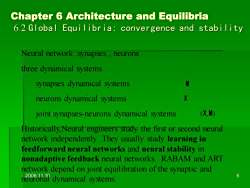
Chapter 6 Architecture and Equilibria 6.2 Global Equilibria:convergence and stability Neural network synapses neurons three dynamical systems synapses dynamical systems M neurons dynamical systems X joint synapses-neurons dynamical systems (X.M) Historically,Neural engineers study the first or second neural network independently.They usually study learning in feedforward neural networks and neural stability in nonadaptive feedback neural networks.RABAM and ART network depend on joint equilibration of the synaptic and n2081a9 dynamical systems. 5
2006.11.10 5 Chapter 6 Architecture and Equilibria 6.2 Global Equilibria: convergence and stability Neural network :synapses , neurons three dynamical systems synapses dynamical systems neurons dynamical systems joint synapses-neurons dynamical systems Historically,Neural engineers study the first or second neural network independently .They usually study learning in feedforward neural networks and neural stability in nonadaptive feedback neural networks. RABAM and ART network depend on joint equilibration of the synaptic and neuronal dynamical systems. ' M ' X ( , ) ' ' X M
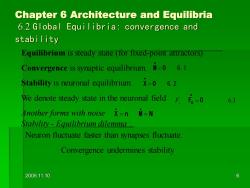
Chapter 6 Architecture and Equilibria 6.2 Global Equilibria:convergence and stabi lity Equilibrium is steady state (for fixed-point attractors) Convergence is synaptic equilibrium.M=0 6.1 Stability is neuronal equilibrium.X=0 6.2 We denote steady state in the neuronal field F=0 6.3 Another forms with noise x=n M=N Stability-Equilibrium dilemma: Neuron fluctuate faster than synapses fluctuate Convergence undermines stability 2006.11.10 6
2006.11.10 6 Chapter 6 Architecture and Equilibria 6.2 Global Equilibria: convergence and stability Equilibrium is steady state (for fixed-point attractors) Convergence is synaptic equilibrium. Stability is neuronal equilibrium. We denote steady state in the neuronal field Another forms with noise Stability - Equilibrium dilemma : Neuron fluctuate faster than synapses fluctuate. Convergence undermines stability M = 0 6.1 • X = 0 6.2 • F x Fx = 0 6.3 • • • X n M N = =
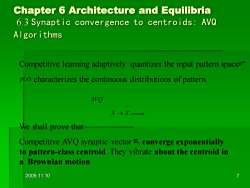
Chapter 6 Architecture and Equilibria 6.3 Synaptic convergence to centroids:AVQ Al gor i thms Competitive learning adaptively quantizes the input pattern spaceR" p(x)characterizes the continuous distributions of pattern AVO X-→X centroid We shall prove that: Competitive AVQ synaptic vector m,converge exponentially to pattern-class centroid.They vibrate about the centroid in a Brownian motion 2006.11.10 7
2006.11.10 7 Chapter 6 Architecture and Equilibria 6.3 Synaptic convergence to centroids: AVQ Algorithms We shall prove that: Competitive AVQ synaptic vector converge exponentially to pattern-class centroid. They vibrate about the centroid in a Brownian motion m j Competitive learning adaptively quantizes the input pattern space characterizes the continuous distributions of pattern. n R p(x) X X centroid AVQ ^ →
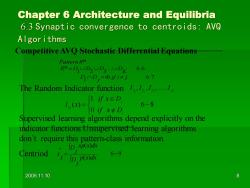
Chapter 6 Architecture and Equilibria 6.3 Synaptic convergence to centroids:AVQ Algor i thms Competitive AVQ Stochastic Differential Equations Pattern Rn Rn=DOD2UD3DK 6.6 DnD=D,fi≠j 6.7 The Random Indicator function... 1.()=ixeD 6-8 oif xD Supervised learning algorithms depend explicitly on the indicator functions.Unsupervised learning algorithms don't require this pattern-class information. ID.xp(x)dx Centriod 6-9 (x)dx 2006.11.10 8
2006.11.10 8 Chapter 6 Architecture and Equilibria 6.3 Synaptic convergence to centroids: AVQ Algorithms , 6.7 .... 6.6 1 2 3 if i j j D i D K Rn D D D D PatternRn = = The Random Indicator function Supervised learning algorithms depend explicitly on the indicator functions.Unsupervised learning algorithms don’t require this pattern-class information. Centriod D D D DK I ,I ,I ,......I 1 2 3 6 8 0 1 ( ) − = j j D i f x D i f x D I x j 6 9 ( ) ( ) ^ − = j D p x dx j D xp x dx j x Competitive AVQ Stochastic Differential Equations
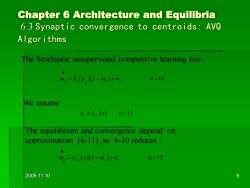
Chapter 6 Architecture and Equilibria 6.3 Synaptic convergence to centroids:AVQ Al gor i thms The Stochastic unsupervised competitive learning law: m)=S0y儿x-m]+n 6-10 We assume S≈ID(x)6-11 The equilibrium and convergence depend on approximation (6-11),so 6-10 reduces m=D(x儿x-m]+n 6-12 2006.11.10 9
2006.11.10 9 Chapter 6 Architecture and Equilibria 6.3 Synaptic convergence to centroids: AVQ Algorithms The Stochastic unsupervised competitive learning law: = ( )[ − ]+ 6 −10 • j j j mj nj m S y x S I (x) 6−11 Dj j We assume The equilibrium and convergence depend on approximation (6-11) ,so 6-10 reduces : = ( )[ − ]+ 6 −12 • j D mj nj m I x x j
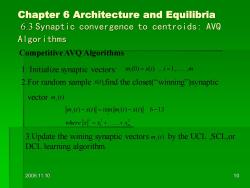
Chapter 6 Architecture and Equilibria 6.3 Synaptic convergence to centroids:AVQ Al gor ithms Competitive AVQ Algorithms 1.Initialize synaptic vectors: m,(0)=x(0,i=1,…,m 2.For random sample x()find the closet("winning")synaptic vector m (t) m,(0)-x0)=minm,(0-x06-13 where x=++x 3.Update the wining synaptic vectors()by the UCL.SCL,or DCL learning algorithm. 2006.11.10 10
2006.11.10 10 Chapter 6 Architecture and Equilibria 6.3 Synaptic convergence to centroids: AVQ Algorithms Competitive AVQ Algorithms 1. Initialize synaptic vectors: mi (0) = x(i) , i =1,......,m 2.For random sample ,find the closet(“winning”)synaptic vector x(t) m (t) j 2 2 1 2 ....... ( ) ( ) min ( ) ( ) 6 13 m i i j where x x x m t x t m t x t = + + − = − − 3.Update the wining synaptic vectors by the UCL ,SCL,or DCL learning algorithm. m (t) j
按次数下载不扣除下载券;
注册用户24小时内重复下载只扣除一次;
顺序:VIP每日次数-->可用次数-->下载券;
- 西安电子科技大学:《神经网络与模糊系统 Neural Networks and Fuzzy Systems》课程PPT课件讲稿(2006)Chapter 05-3 突触动力学Ⅱ:有监督的学习.ppt
- 西安电子科技大学:《神经网络与模糊系统 Neural Networks and Fuzzy Systems》课程PPT课件讲稿(2006)Chapter 10 模糊图像变换编码.ppt
- 西安电子科技大学:《神经网络与模糊系统 Neural Networks and Fuzzy Systems》课程PPT课件讲稿(2006)Chapter 05-2 Backpropagation Algorithm.ppt
- 西安电子科技大学:《神经网络与模糊系统 Neural Networks and Fuzzy Systems》课程PPT课件讲稿(2006)Chapter 05-1 突触动力学Ⅱ——有监督学习.ppt
- 西安电子科技大学:《神经网络与模糊系统 Neural Networks and Fuzzy Systems》课程PPT课件讲稿(2006)Chapter 04-3 Part3 Differential Heb learning & Differential Competitive learning.ppt
- 西安电子科技大学:《神经网络与模糊系统 Neural Networks and Fuzzy Systems》课程PPT课件讲稿(2006)Chapter 04-2 Synaptic Dynamics:Unsupervised Learning Part Ⅱ.ppt
- 西安电子科技大学:《神经网络与模糊系统 Neural Networks and Fuzzy Systems》课程PPT课件讲稿(2006)Chapter 04-1 Synaptic Dynamics:Unsupervised Learning Part Ⅰ.ppt
- 西安电子科技大学:《神经网络与模糊系统 Neural Networks and Fuzzy Systems》课程PPT课件讲稿(2006)Chapter 03-2 NEURONAL DYNAMICS 2:ACTIVATION MODELS.ppt
- 西安电子科技大学:《神经网络与模糊系统 Neural Networks and Fuzzy Systems》课程PPT课件讲稿(2006)Chapter 03-1 NEURONAL DYNAMICS 2:ACTIVATION MODELS.ppt
- 西安电子科技大学:《神经网络与模糊系统 Neural Networks and Fuzzy Systems》课程PPT课件讲稿(2006)Chapter 02 NEURAL DYNAMIC1:ACTIVATIONHS AND SIGNALS(主讲:高新波).ppt
- 西安电子科技大学:《神经网络与模糊系统 Neural Networks and Fuzzy Systems》课程PPT课件讲稿(2004)Chapter 09-1 模糊与神经网络倒车系统比较.ppt
- 西安电子科技大学:《神经网络与模糊系统 Neural Networks and Fuzzy Systems》课程PPT课件讲稿(2004)Chapter 11 模糊与卡尔曼滤波目标跟踪控制系统的比较 Comparison of Fuzzy and Kalman-Filter Target-Tracking control system.ppt
- 西安电子科技大学:《神经网络与模糊系统 Neural Networks and Fuzzy Systems》课程PPT课件讲稿(2004)Chapter 09-2 模糊倒车控制系统——拖斗拖车.ppt
- 西安电子科技大学:《神经网络与模糊系统 Neural Networks and Fuzzy Systems》课程PPT课件讲稿(2004)Chapter 08-2 Fuzzy Associative Memories 模糊联想记忆 FUZZY ASSOCIATIVE MEMMORIESⅡ.ppt
- 西安电子科技大学:《神经网络与模糊系统 Neural Networks and Fuzzy Systems》课程PPT课件讲稿(2004)Chapter 10 模糊图像变换编码.ppt
- 西安电子科技大学:《神经网络与模糊系统 Neural Networks and Fuzzy Systems》课程PPT课件讲稿(2004)Chapter 08-1 Fuzzy Associative Memories.ppt
- 西安电子科技大学:《神经网络与模糊系统 Neural Networks and Fuzzy Systems》课程PPT课件讲稿(2004)Chapter 07-2 Fuzziness vs. Probability 模糊集合的模糊程度——模糊熵.ppt
- 西安电子科技大学:《神经网络与模糊系统 Neural Networks and Fuzzy Systems》课程PPT课件讲稿(2004)Chapter 07-1 Fuzziness vs. Probability.ppt
- 西安电子科技大学:《神经网络与模糊系统 Neural Networks and Fuzzy Systems》课程PPT课件讲稿(2004)Chapter 06 Architecture and Equilibra 结构和平衡.ppt
- 西安电子科技大学:《神经网络与模糊系统 Neural Networks and Fuzzy Systems》课程PPT课件讲稿(2004)Chapter 05-2 Synaptic DynamicsII:Supervised Learning.ppt
- 西安电子科技大学:《神经网络与模糊系统 Neural Networks and Fuzzy Systems》课程PPT课件讲稿(2006)Chapter 07-1 模糊与概率(一).ppt
- 西安电子科技大学:《神经网络与模糊系统 Neural Networks and Fuzzy Systems》课程PPT课件讲稿(2006)Chapter 07-2 模糊与概率(二).ppt
- 西安电子科技大学:《神经网络与模糊系统 Neural Networks and Fuzzy Systems》课程PPT课件讲稿(2006)Chapter 08-1 Fuzzy Associative Memories(1/3).ppt
- 西安电子科技大学:《神经网络与模糊系统 Neural Networks and Fuzzy Systems》课程PPT课件讲稿(2006)Chapter 08-2 Fuzzy Associative Memories(2/3).ppt
- 西安电子科技大学:《神经网络与模糊系统 Neural Networks and Fuzzy Systems》课程PPT课件讲稿(2006)Chapter 08-3 Fuzzy Associative Memories(3/3).ppt
- 西安电子科技大学:《神经网络与模糊系统 Neural Networks and Fuzzy Systems》课程PPT课件讲稿(2006)Chapter 11 模糊与卡尔曼滤波目标跟踪控制系统的比较 Comparison of Fuzzy and Kalman-Filter Target-Tracking control system.ppt
- 西安电子科技大学:《神经网络与模糊系统 Neural Networks and Fuzzy Systems》课程PPT课件讲稿(2006)Chapter 09 模糊与神经网络的比较——以倒车系统为例.ppt
- 西安电子科技大学:《神经网络与模糊系统 Neural Networks and Fuzzy Systems》课程PPT课件讲稿(2003)04. 突触动力学Ⅱ:有监督学习 Synaptic Dynamics II——Supervised Learning(1/2).ppt
- 西安电子科技大学:《模糊理论与模糊系统 Fuzzy Theory and Fuzzy Systems》课程教学资源(课件讲义)第一章 绪论——模糊聚类分析(主讲:高新波).pdf
- 西安电子科技大学:《模糊理论与模糊系统 Fuzzy Theory and Fuzzy Systems》课程教学资源(课件讲义)第二章 模糊理论基础 第一部分 普通集合、模糊集合、分解定理与扩展原理.pdf
- 西安电子科技大学:《模糊理论与模糊系统 Fuzzy Theory and Fuzzy Systems》课程教学资源(课件讲义)第二章 模糊理论基础 第二部分 模糊不确定性度量、模糊集的模糊性度量、模糊事件的概率.pdf
- 西安电子科技大学:《模糊理论与模糊系统 Fuzzy Theory and Fuzzy Systems》课程教学资源(课件讲义)第二章 模糊理论基础 第三部分 模糊数及其扩展运算、模糊关系.pdf
- 浙江开放大学:《液压与气压传动》模拟试题一及答案.doc
- 国家开放大学:2006—2007学年第一学期“开放本科”机械制造专业机电一体化系统设计基础期末试题(1月).pdf
- 国家开放大学:2006—2007学年第一学期“开放本科”机械制造专业机电控制与可编程序控制器技术期末试题(1月).pdf
- 国家开放大学:2006—2007学年第一学期“开放本科”机械制造专业机电控制工程基础期末试题(1月).pdf
- 国家开放大学:2006—2007学年第一学期“开放本科”机械制造专业液压气动技术期末试题(1月).pdf
- 国家开放大学:2006—2007学年第二学期“开放本科”机械制造专业机电一体化系统设计基础期末试题(7月).pdf
- 国家开放大学:2006—2007学年第二学期“开放本科”机械制造专业机电控制与可编程序控制器技术期末试题(7月).pdf
- 国家开放大学:2006—2007学年第二学期“开放本科”机械制造专业机电控制工程基础期末试题(半开卷).pdf
